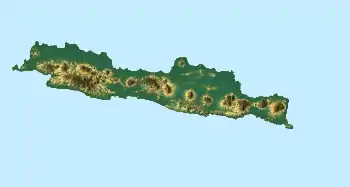Elephas hysudrindicus
Elephas hysudrindicus, commonly known also as the Blora elephant in Indonesia (lit. Gajah Blora in Indonesian) is a species of extinct elephant from the Pleistocene of Java. It has anatomical distinctions from the Asian elephant, the last remaining species of elephant under the genus Elephas.[1]
| Elephas hysudrindicus Temporal range: Pleistocene | |
|---|---|
 | |
| Elephas hysudrindicus in the Bandung Geological Museum | |
| Scientific classification | |
| Kingdom: | Animalia |
| Phylum: | Chordata |
| Class: | Mammalia |
| Order: | Proboscidea |
| Family: | Elephantidae |
| Genus: | Elephas |
| Species: | †E. hysudrindicus |
| Binomial name | |
| †Elephas hysudrindicus Dubois, 1908 | |
 | |
| Sunggun Archaeological Site in Blora, Java | |
The head of the Bandung Geological Museum, Yunus Kusumbrata has claimed that this species existed about 15,000 years ago.[2]
History of discovery
The type fossil was excavated in the Sunggun archaeological site, Medalem, Kradenan Subregency, Blora in March 2009. It was found almost completely intact (estimating about 90%) about a few feet under the dirt in a former sand quarry in the village.[3][4] It was then brought to the Bandung Geological Museum which was then put to display.[2]
References
- Hooijer, D. A. (1955). Fossil Proboscidea from the Malay Archipelago and the Punjab. Zoologische Verhandelingen, 28 (1): 1–146.
- "Museum gets pre-historic elephant bones". The Jakarta Post. Retrieved 30 August 2021.
- webadmin. "Replika Fosil Gajah Purba Blora Bisa Dikunjungi Setiap Hari". Pemerintah Kabupaten Blora. Retrieved 2021-08-30.
- "Fossils of prehistoric elephant, leaf found in Blora This article was published in thejakartapost.com with the title " Fossils of prehistoric elephant, leaf found in Blora". 23 April 2009. Retrieved 30 August 2021.